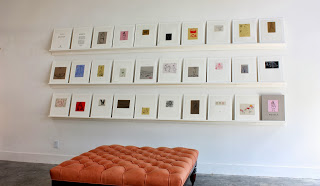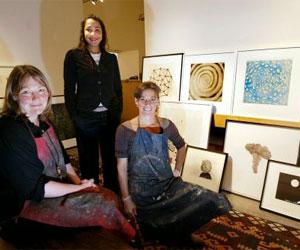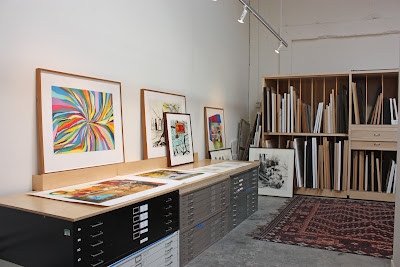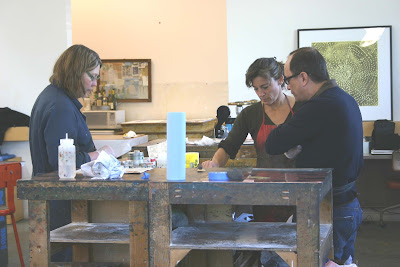We took all of these images and snippets and staticky things and put them together in one sheet. And then we went from there to doing individual plates and then putting them together and then separating. Back and forth.
When you’re alone in the studio, you have to make your decisions, for better or for worse. Here, when there are people who can give you feedback, I find myself in a bit of a fog, but not in a bad fog—in a very, very good fog.
No. I have negative assistants. I have resistance. I’m just in my studio wandering around.
Yes.
Yes. I could paint on this. And I tried drawing some. This paper drives me crazy with happiness. I want like my whole life to be this.
Whose idea was it to print on cloth?
I wanted to print on cloth because I do a lot of embroidery stuff. And I thought, okay, it’s cloth, and then we’ll draw, and maybe try some embroidery. But the embroidery that I’ve tried feels unnecessary.

For me that’s part of the process—that we went to a nearby fabric store and saw what they had—and they had wonderful things.
Can you talk about some of these images you brought with you to use for reference?
This is an airplane. It’s like the early airplanes.
Like Kitty Hawk?
Exactly, but it may be upside down. I’m not sure. And this was a dancer from New York. I cut out a lot of photographs, so this is a woman that performed a few years ago. Half the time I don’t know where I cut out the images from anymore, but she’s a dancer, and this is also a dance troupe. So the movements of people making it through the day, both intentionally as dancers, and then just how we move around really fascinates me a lot. There’s a man behind her in the photo, holding his hands on her shoulders. But she’s a little bit awkward.
I’m always watching how people are walking, and following them and photographing how people walk and really struggle—a lot of yearning to be okay, and dignity, and being brave. Basically I think everybody’s very brave for getting up in the morning and continuing through the day. Sometimes people walking, people sitting and eating, are just heartbreaking. I love Diane Arbus when she went to visit the people in the home and the Halloween images of those people. That’s also a Lartigue, but the photo is of a woman looking up at this ball, and then it became something else. It became a woman holding a stick. And then there is the rollercoaster after Hurricane Sandy.
I’m always drawing into the plate, either the hard ground or the sugar lift. It only took me four days to remember those four words—hard ground, sugar lift.
It’s like a nice poem.
Yes. I think that the problem is, putting the word “poetry” on it—it depends what kind of mood you’re in: poetry can be a wonderful thing to say about something, and then, as a critic once said about me, “unnecessarily poetic.”
Yes. I don’t want to forget the idea of a sense of humor along with the yearning and the sadness. There’s a lightness balancing the heaviness. And so poetry would imply one thing, and then just saying “I don’t know” would be the other.
No. But a lot of the things that I write or things in the books are poems. The dog says, okay, I’m going to write a poem now. I’m going to close my eyes and think of three things and then make a poem out of that. So there’s a lot of poetry and there’s a lot of songwriting in the children’s books. But I am collaborating with Gertrude Stein [in the set designs for the Mark Morris Dance Group’s production of Stein’s opera Four Saints in Three Acts]. So yes, I’m collaborating with a poet whom I never met.
I hope that if she were alive she’d go, “Great,” as opposed to, “Don’t you dare.”
I found a copy of the book one summer and thought, “Oh my God, this is a crazy great book, and I need to illustrate it.” It’s the randomness of each sentence. The continuity comes from [Strunk and White’s] wit and the vivid cinematic images that they use. You don’t have to worry about a plot.
Of course I want to come back some time in the future when it all makes sense. I’ll go home and I’ll be able to moan and go, ugh, what was I thinking, or what was I not thinking? Really, it’s the beginning of a conversation.
I’ve been to Berkeley some other times, and I spent time in San Francisco installing the show at SFMOMA [about her late husband Tibor Kalman]. And then I came here to this gallery, and I said, “This is an amazing space. I love being here.”
Well, I walk from my bed-and-breakfast in the morning. It’s over a mile. But that’s also the graph of the day—that sometimes you’re just sitting there like a stunned animal, not knowing what’s going on. We are animals that sort of freeze, and then—well I guess it’s like a possum, but a possum plays dead for something else. But I feel like sometimes I’m an animal that all of a sudden is dead. And then all of a sudden I come back to life.
One of the things I did in Rome was go watch people pray, because I was trying to say, “What exactly are you doing? What are you doing on your knees? What do you think is going to happen here?” The intensity of people publically displaying their emotions and their grief and their hope, it’s incredible. Plus in Naples there were a lot of places where people are in confession and the priest is just sitting up, kneeling opposite them, not in a little contained cubicle, just open.
The thing is that if you’re in the formal construct of a church or a synagogue and you’re praying to a deity, as opposed to praying for the strength to deal with whatever tragedy might befall you, and you are looking for a deity to save you, that feels delusional. I say “Oh my god” a thousand times a day. Then I say, “But I don’t believe in God.” And i am really not sure which statement is true.











